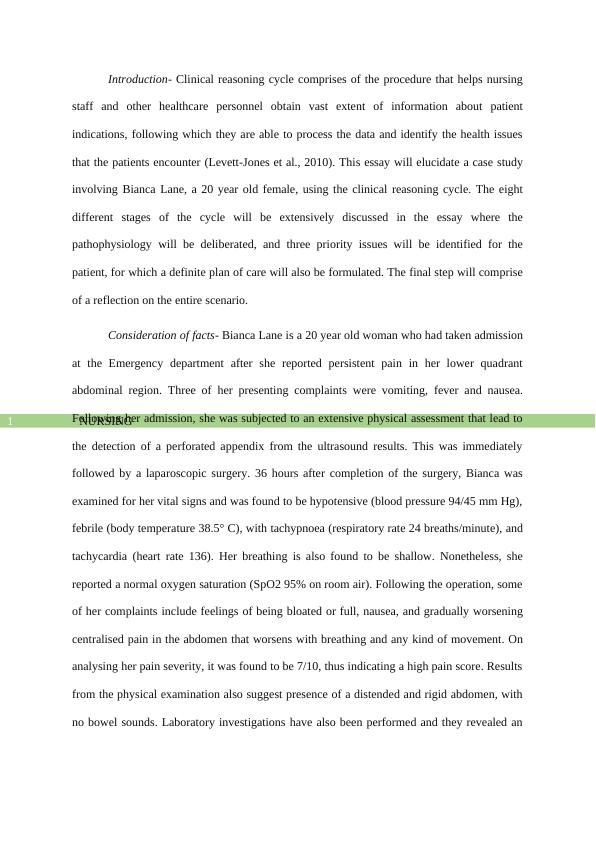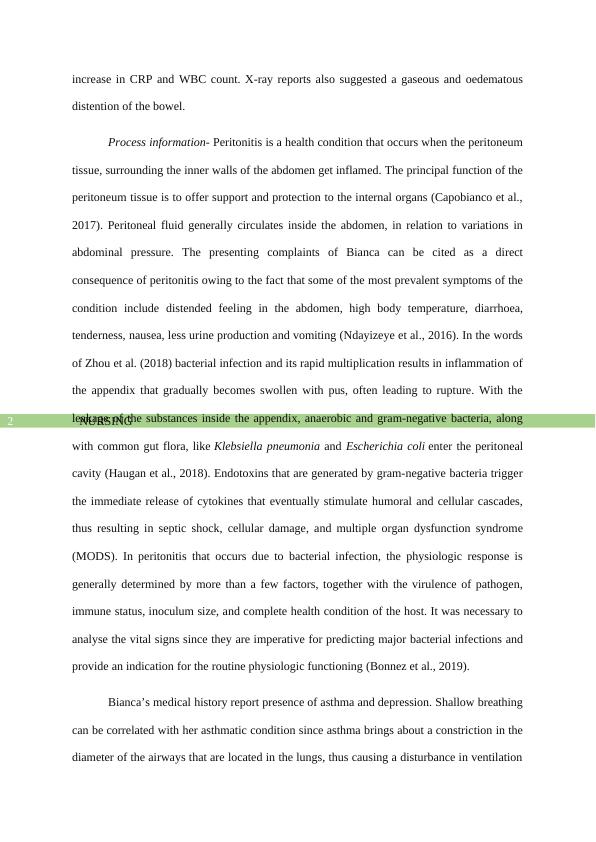NRSG370 – Clinical Integration - Specialty Practice
Notification of eligibility for a supplementary assessment for the unit NRSG370
10 Pages3041 Words16 Views
Added on 2022-09-07
NRSG370 – Clinical Integration - Specialty Practice
Notification of eligibility for a supplementary assessment for the unit NRSG370
Added on 2022-09-07
ShareRelated Documents
Running head: NURSING
NRSG370 – Clinical Integration - Speciality Practice
Student Name:
Student ID Number:
Speciality Area:
Scenario:
Total number of words:
NRSG370 – Clinical Integration - Speciality Practice
Student Name:
Student ID Number:
Speciality Area:
Scenario:
Total number of words:

NURSING1
Introduction- Clinical reasoning cycle comprises of the procedure that helps nursing
staff and other healthcare personnel obtain vast extent of information about patient
indications, following which they are able to process the data and identify the health issues
that the patients encounter (Levett-Jones et al., 2010). This essay will elucidate a case study
involving Bianca Lane, a 20 year old female, using the clinical reasoning cycle. The eight
different stages of the cycle will be extensively discussed in the essay where the
pathophysiology will be deliberated, and three priority issues will be identified for the
patient, for which a definite plan of care will also be formulated. The final step will comprise
of a reflection on the entire scenario.
Consideration of facts- Bianca Lane is a 20 year old woman who had taken admission
at the Emergency department after she reported persistent pain in her lower quadrant
abdominal region. Three of her presenting complaints were vomiting, fever and nausea.
Following her admission, she was subjected to an extensive physical assessment that lead to
the detection of a perforated appendix from the ultrasound results. This was immediately
followed by a laparoscopic surgery. 36 hours after completion of the surgery, Bianca was
examined for her vital signs and was found to be hypotensive (blood pressure 94/45 mm Hg),
febrile (body temperature 38.5° C), with tachypnoea (respiratory rate 24 breaths/minute), and
tachycardia (heart rate 136). Her breathing is also found to be shallow. Nonetheless, she
reported a normal oxygen saturation (SpO2 95% on room air). Following the operation, some
of her complaints include feelings of being bloated or full, nausea, and gradually worsening
centralised pain in the abdomen that worsens with breathing and any kind of movement. On
analysing her pain severity, it was found to be 7/10, thus indicating a high pain score. Results
from the physical examination also suggest presence of a distended and rigid abdomen, with
no bowel sounds. Laboratory investigations have also been performed and they revealed an
Introduction- Clinical reasoning cycle comprises of the procedure that helps nursing
staff and other healthcare personnel obtain vast extent of information about patient
indications, following which they are able to process the data and identify the health issues
that the patients encounter (Levett-Jones et al., 2010). This essay will elucidate a case study
involving Bianca Lane, a 20 year old female, using the clinical reasoning cycle. The eight
different stages of the cycle will be extensively discussed in the essay where the
pathophysiology will be deliberated, and three priority issues will be identified for the
patient, for which a definite plan of care will also be formulated. The final step will comprise
of a reflection on the entire scenario.
Consideration of facts- Bianca Lane is a 20 year old woman who had taken admission
at the Emergency department after she reported persistent pain in her lower quadrant
abdominal region. Three of her presenting complaints were vomiting, fever and nausea.
Following her admission, she was subjected to an extensive physical assessment that lead to
the detection of a perforated appendix from the ultrasound results. This was immediately
followed by a laparoscopic surgery. 36 hours after completion of the surgery, Bianca was
examined for her vital signs and was found to be hypotensive (blood pressure 94/45 mm Hg),
febrile (body temperature 38.5° C), with tachypnoea (respiratory rate 24 breaths/minute), and
tachycardia (heart rate 136). Her breathing is also found to be shallow. Nonetheless, she
reported a normal oxygen saturation (SpO2 95% on room air). Following the operation, some
of her complaints include feelings of being bloated or full, nausea, and gradually worsening
centralised pain in the abdomen that worsens with breathing and any kind of movement. On
analysing her pain severity, it was found to be 7/10, thus indicating a high pain score. Results
from the physical examination also suggest presence of a distended and rigid abdomen, with
no bowel sounds. Laboratory investigations have also been performed and they revealed an

NURSING2
increase in CRP and WBC count. X-ray reports also suggested a gaseous and oedematous
distention of the bowel.
Process information- Peritonitis is a health condition that occurs when the peritoneum
tissue, surrounding the inner walls of the abdomen get inflamed. The principal function of the
peritoneum tissue is to offer support and protection to the internal organs (Capobianco et al.,
2017). Peritoneal fluid generally circulates inside the abdomen, in relation to variations in
abdominal pressure. The presenting complaints of Bianca can be cited as a direct
consequence of peritonitis owing to the fact that some of the most prevalent symptoms of the
condition include distended feeling in the abdomen, high body temperature, diarrhoea,
tenderness, nausea, less urine production and vomiting (Ndayizeye et al., 2016). In the words
of Zhou et al. (2018) bacterial infection and its rapid multiplication results in inflammation of
the appendix that gradually becomes swollen with pus, often leading to rupture. With the
leakage of the substances inside the appendix, anaerobic and gram-negative bacteria, along
with common gut flora, like Klebsiella pneumonia and Escherichia coli enter the peritoneal
cavity (Haugan et al., 2018). Endotoxins that are generated by gram-negative bacteria trigger
the immediate release of cytokines that eventually stimulate humoral and cellular cascades,
thus resulting in septic shock, cellular damage, and multiple organ dysfunction syndrome
(MODS). In peritonitis that occurs due to bacterial infection, the physiologic response is
generally determined by more than a few factors, together with the virulence of pathogen,
immune status, inoculum size, and complete health condition of the host. It was necessary to
analyse the vital signs since they are imperative for predicting major bacterial infections and
provide an indication for the routine physiologic functioning (Bonnez et al., 2019).
Bianca’s medical history report presence of asthma and depression. Shallow breathing
can be correlated with her asthmatic condition since asthma brings about a constriction in the
diameter of the airways that are located in the lungs, thus causing a disturbance in ventilation
increase in CRP and WBC count. X-ray reports also suggested a gaseous and oedematous
distention of the bowel.
Process information- Peritonitis is a health condition that occurs when the peritoneum
tissue, surrounding the inner walls of the abdomen get inflamed. The principal function of the
peritoneum tissue is to offer support and protection to the internal organs (Capobianco et al.,
2017). Peritoneal fluid generally circulates inside the abdomen, in relation to variations in
abdominal pressure. The presenting complaints of Bianca can be cited as a direct
consequence of peritonitis owing to the fact that some of the most prevalent symptoms of the
condition include distended feeling in the abdomen, high body temperature, diarrhoea,
tenderness, nausea, less urine production and vomiting (Ndayizeye et al., 2016). In the words
of Zhou et al. (2018) bacterial infection and its rapid multiplication results in inflammation of
the appendix that gradually becomes swollen with pus, often leading to rupture. With the
leakage of the substances inside the appendix, anaerobic and gram-negative bacteria, along
with common gut flora, like Klebsiella pneumonia and Escherichia coli enter the peritoneal
cavity (Haugan et al., 2018). Endotoxins that are generated by gram-negative bacteria trigger
the immediate release of cytokines that eventually stimulate humoral and cellular cascades,
thus resulting in septic shock, cellular damage, and multiple organ dysfunction syndrome
(MODS). In peritonitis that occurs due to bacterial infection, the physiologic response is
generally determined by more than a few factors, together with the virulence of pathogen,
immune status, inoculum size, and complete health condition of the host. It was necessary to
analyse the vital signs since they are imperative for predicting major bacterial infections and
provide an indication for the routine physiologic functioning (Bonnez et al., 2019).
Bianca’s medical history report presence of asthma and depression. Shallow breathing
can be correlated with her asthmatic condition since asthma brings about a constriction in the
diameter of the airways that are located in the lungs, thus causing a disturbance in ventilation

End of preview
Want to access all the pages? Upload your documents or become a member.
Related Documents
NRSG370 – Clinical Integration - Speciality Practicelg...
|10
|3206
|13
Bianca’s situation Assessment 2022lg...
|10
|2185
|24
Assessment | Health Case Studylg...
|9
|2298
|19
Clinical Integration Specialty Practice - NRSG370 | Case Studylg...
|11
|2827
|507
Management of Peritonitislg...
|10
|2868
|263
Care for a Peritonitis Patientlg...
|10
|2736
|223
